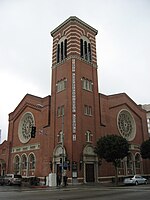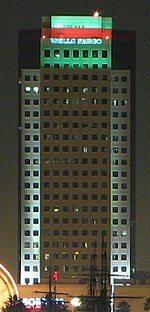One World Trade Center (Long Beach)
Office buildings completed in 1989Skyscraper office buildings in CaliforniaSkyscrapers in Long Beach, CaliforniaWorld Trade Centers

One World Trade Center is a 27-story office building located in Long Beach, California. The building was completed in 1989 and is 397 feet (121 meters) high, making it the tallest building in Long Beach from 1989 to 2021 when it was passed by the Shoreline Gateway Tower. The 20-story Hilton Long Beach is part of the complex and known as Two World Trade Center. There is a helipad located on top of the building known as the World Trade Center Heliport (FAA: 3CL3). The building is clad in granite.
Excerpt from the Wikipedia article One World Trade Center (Long Beach) (License: CC BY-SA 3.0, Authors, Images).One World Trade Center (Long Beach)
West Ocean Boulevard, Long Beach
Geographical coordinates (GPS) Address Nearby Places Show on map
Geographical coordinates (GPS)
| Latitude | Longitude |
|---|---|
| N 33.76774 ° | E -118.19984 ° |
Address
World Trade Center Heliport
West Ocean Boulevard
90834 Long Beach
California, United States
Open on Google Maps






